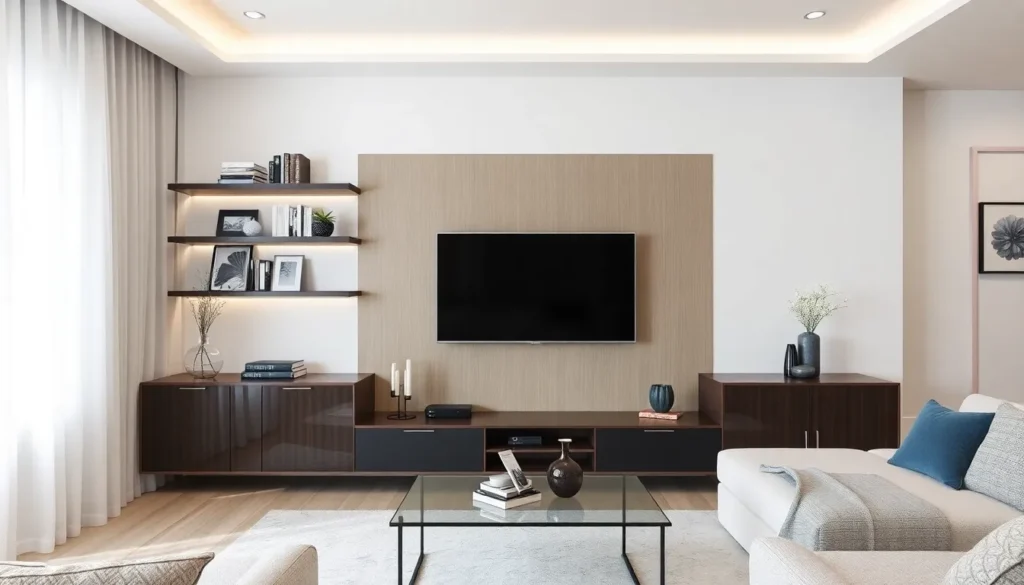Are you tired of staring at a blank wall where your TV is mounted? You’re not alone. Many of us want our living rooms to look inviting and stylish while also being functional. That’s why I created this post—because finding the perfect balance between aesthetics and utility can be tricky. With so many options available, it’s easy to feel overwhelmed when designing your living room TV wall.
This post is for anyone who loves home decor and wants to elevate their living space. Whether you’re a minimalist at heart or just looking for a fresh take on modern living room decor, you’ll find something here that resonates with you. You want a stylish media center that not only serves its purpose but also adds a touch of elegance to your home.
In this article, you’ll discover over 25 living room TV wall ideas that beautifully combine function and style. From minimalist floating shelves to textured accent walls, each idea is designed to inspire you. You’ll learn about space-saving furniture solutions and creative TV wall designs that make your living room a cozy haven. So, let’s dive in and transform your TV wall into a stunning focal point that reflects your personal style!
Key Takeaways
– Explore over 25 unique living room TV wall ideas that blend functionality and style seamlessly.
– Discover how minimalist floating shelves can create an open feel while providing ample storage.
– Learn about textured accent walls that add depth and character to your media space.
– Get ideas for integrating multi-functional furniture for a clutter-free environment.
– Find out how artistic displays and statement lighting can elevate the overall ambiance of your living room.
1. Minimalist Floating Shelves
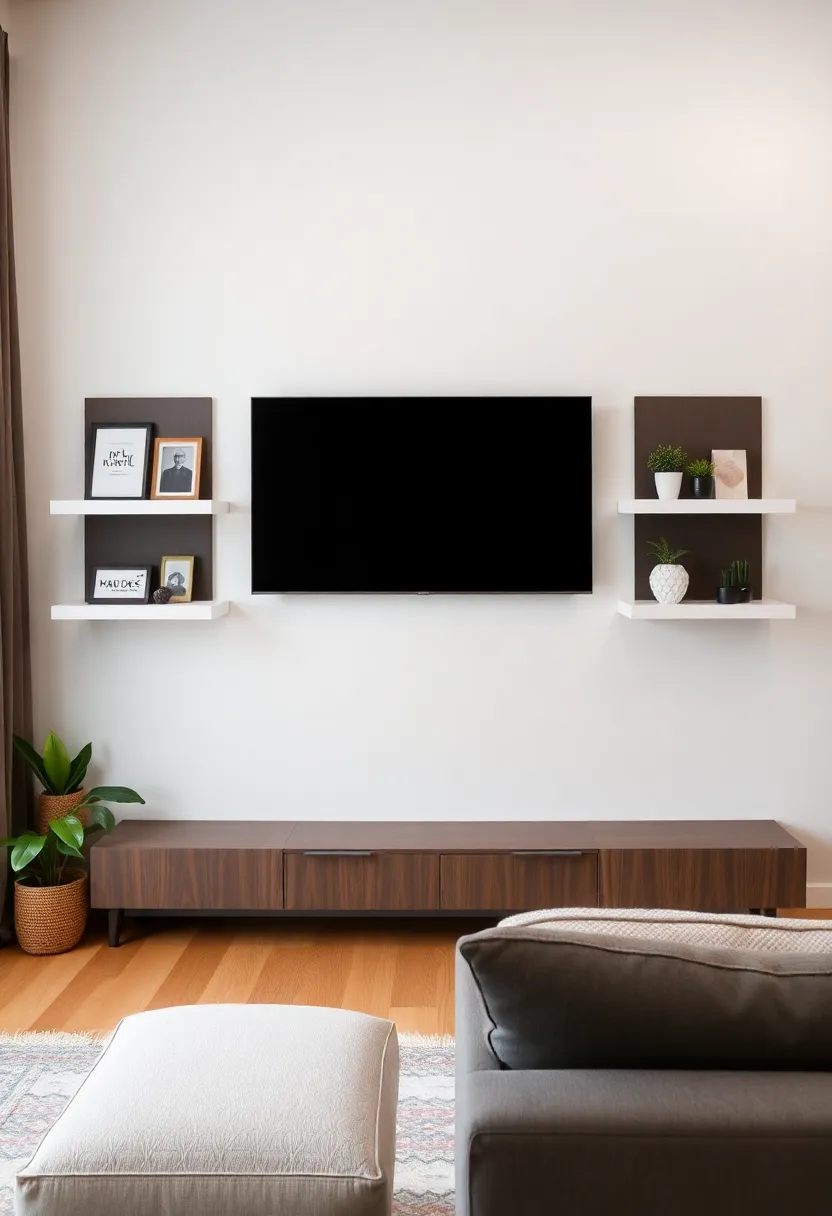
Minimalist floating shelves bring a fresh, airy feel to your living room. They let your TV shine while offering space to display books, plants, or decorative items. You can choose soft white shelves or natural wood tones, creating a clean, modern look. Pinterest is buzzing with ideas on how to style these shelves beautifully, making it a popular choice among design enthusiasts.
To implement this style, consider placing two or three shelves on either side of your TV. This creates a balanced look without overwhelming your space. You can find budget-friendly options at local thrift stores or online marketplaces. A minimalist design keeps your living room looking tidy and inviting, perfect for cozy movie nights.
• Use LED strip lights underneath for ambiance.
• Pick succulents for low-maintenance greenery.
• Keep decor minimal to avoid clutter.
• Choose statement pieces to focus on.
With these tips, your living room can feel open and stylish, showcasing your personal flair.
Minimalist Floating Shelves
Editor’s Choice

QEEIG Bathroom Floating Shelves for Wall – 15.7″ Wall Mounted Shelf Over…
 Amazon$16.92
Amazon$16.92
KSIPZE 100ft Led Strip Lights RGB Music Sync Color Changing Bluetooth Le…
 Amazon$9.99
Amazon$9.99
Costa Farms Live Plants (Pack of 2), Easy to Grow Live Indoor Houseplant…
 Amazon$25.99
Amazon$25.992. Textured Accent Wall
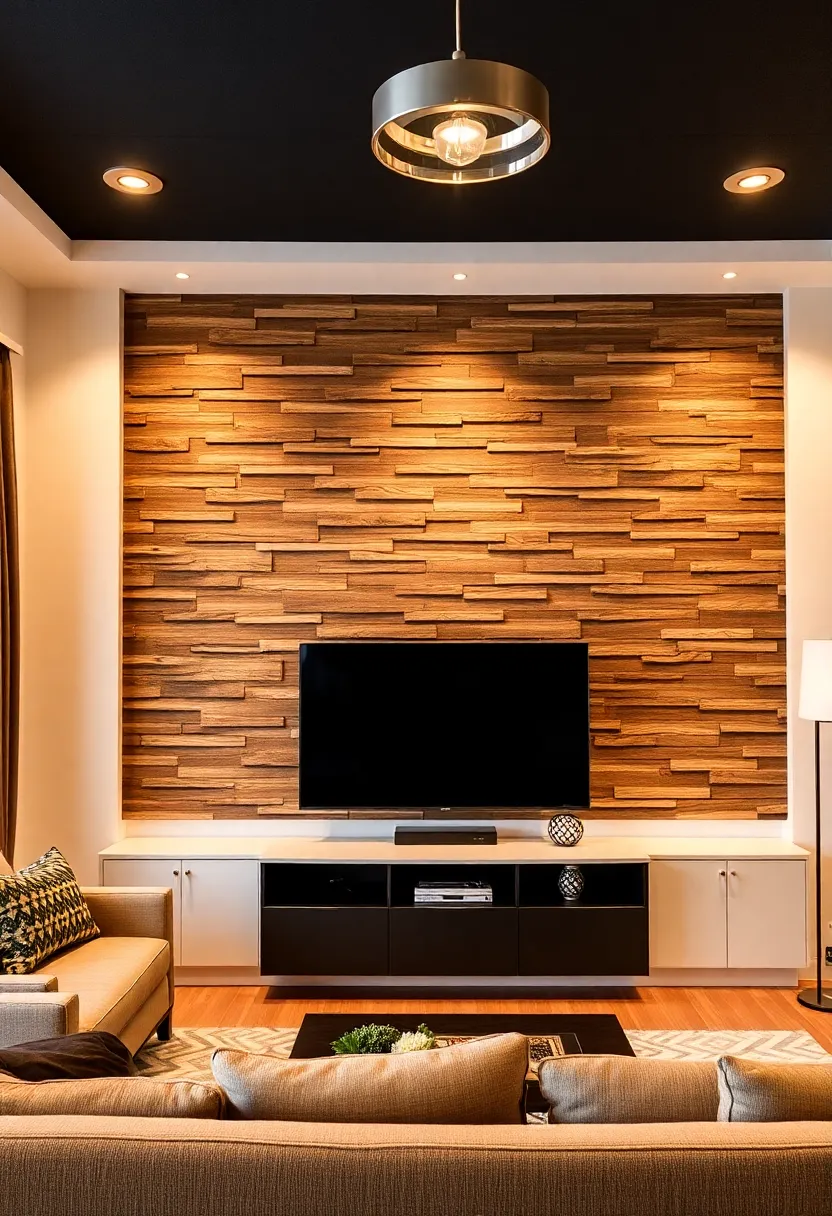
A textured accent wall can dramatically change the vibe of your living room. Think reclaimed wood or exposed brick to create a stunning backdrop for your TV. This design not only adds visual interest but also makes your TV wall a standout feature, as seen in many modern homes. Choose soft colors that complement your furniture for a balanced look.
When designing your wall, consider adding subtle lighting, like sconces, to enhance the textures. You can find affordable materials at local home improvement stores to keep costs down. This design approach creates an inviting atmosphere, making your space feel cozy and stylish.
• Use reclaimed wood for a rustic look.
• Balance with sleek furniture to avoid heaviness.
• Explore textured wallpaper for easy application.
• Choose paint colors that harmonize with your decor.
With these ideas, your living room can embody warmth and style, perfect for relaxation.
Textured Accent Wall
Editor’s Choice

Peel & Stick Real Wood Planks, Rustic Reclaimed Barn Wood Paneling, Brow…
 Amazon$59.99
Amazon$59.99
Homax 41072040969 Wall Texture Goes On Blue/Dries White, 16 oz, Orange P…
 Amazon$16.83
Amazon$16.83
Farmhouse Wood Candle Sconces Wall Decor – Set of 2 Walasis Rustic Wall …
 Amazon$29.98
Amazon$29.983. Integrated Media Center
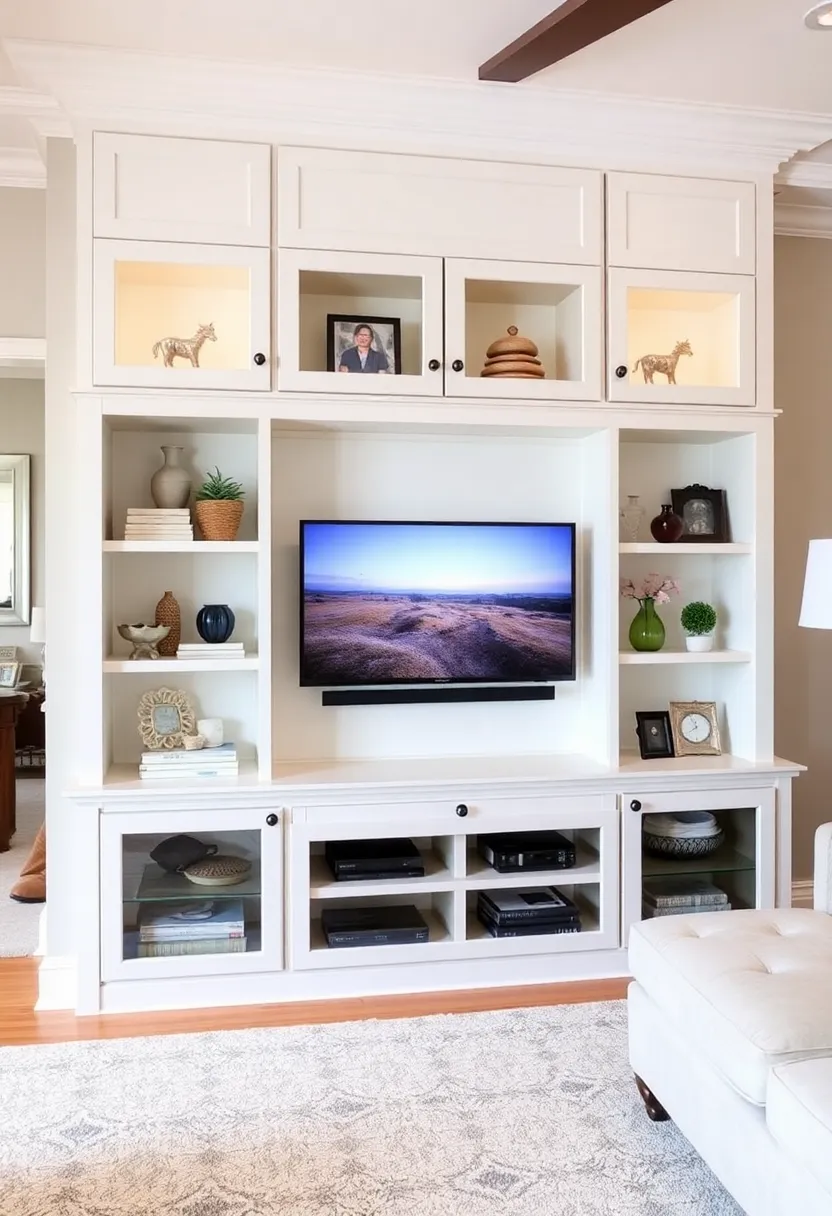
Think about integrating your TV into a stylish media center for a clean, functional look. Built-in cabinetry around your TV can store electronics and keep your space clutter-free. This design is practical and offers a sleek appearance, aligning with modern design trends. Choose materials like warm woods or sleek metals to match your existing decor.
For a balanced design, consider a mix of open and closed storage. You can find affordable cabinetry at furniture stores or even build your own. This setup keeps your living room looking tidy while providing easy access to your items, creating a peaceful retreat at home.
• Organize cables with management systems.
• Use matching bins for storage.
• Incorporate soft-close hinges for sleek operation.
• Consider painted finishes for a custom look.
With these tips, your living room can feel organized and stylish, making it a perfect gathering space.
Integrated Media Center
Editor’s Choice

N NOROCME 192 PCS Cable Management Kit 4 Wire Organizer Sleeve,11 Cable …
 Amazon$15.55
Amazon$15.55
IRIS USA 13 Qt Stackable Plastic Storage Bins with Lids, 6 Pack – BPA-Fr…
 Amazon$27.99
Amazon$27.99
Ravinte 60 Pack (30 Pairs) 1/2 Inch Overlay Soft Close Hinges for Kitche…
 Amazon$79.99
Amazon$79.994. Wall-Mounted TV with Decorative Frame
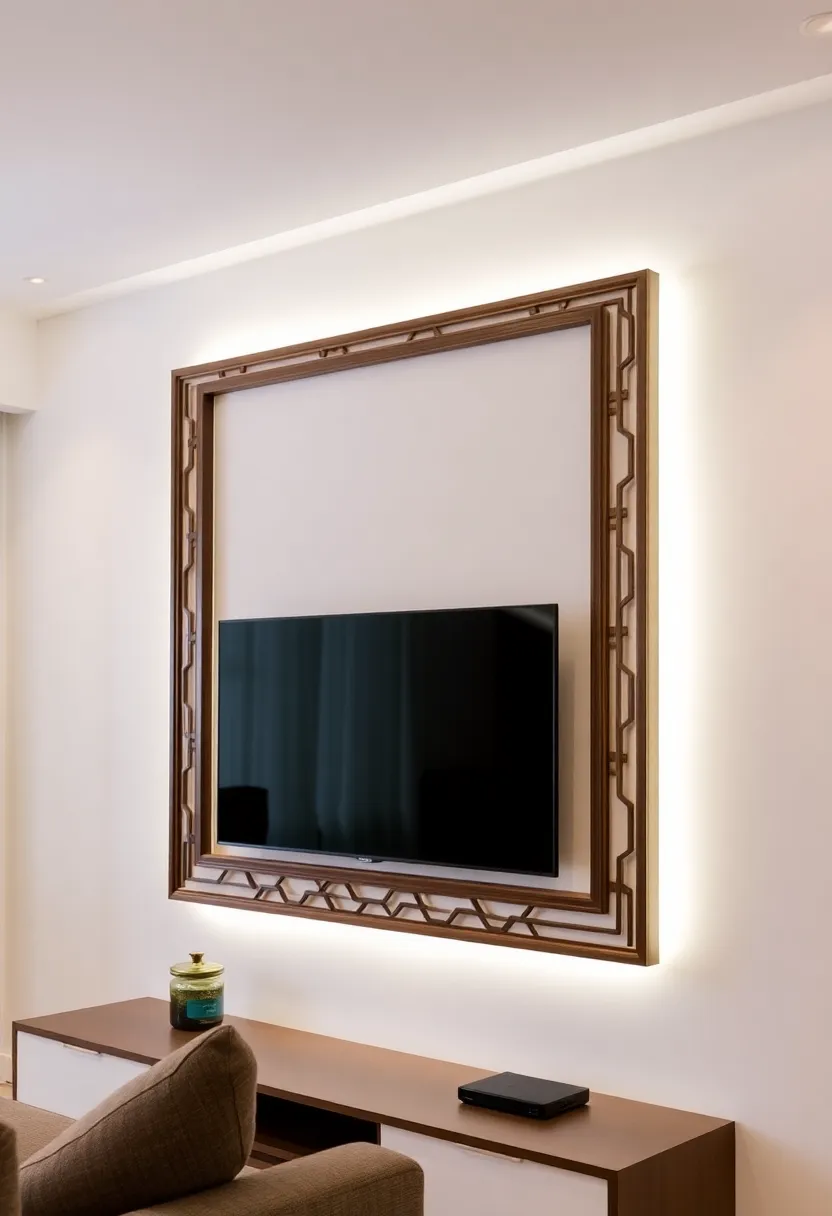
Give your TV a gallery-like appearance by framing it with a decorative border. This not only highlights your TV but also enhances your overall decor. Choose a frame that fits your style—sleek metallics for a modern vibe or rustic wood for a traditional touch. Adding LED lighting can create an elegant glow, making your space feel cozy and inviting.
When selecting a frame, ensure it allows easy access to your TV’s ports. You can find budget-friendly options at home decor stores. This design helps the TV blend in with your decor, making it less of a distraction.
• Choose a frame style that complements your room.
• Consider varying frame widths for interest.
• Use surrounding space for decorative art.
• Add soft lighting behind the frame for ambiance.
With these ideas, your TV can become a stylish focal point in your living room.
Wall-Mounted TV with Decorative Frame
Editor’s Choice

Frame My TV Deco TV Frames Alloy Scoop – Pale Gold Bezel Compatible ONLY…
 Amazon$199.00
Amazon$199.00
LED Lights for TV, 16.4ft LED Lights for 45-75 Inch TVs, RGB TV Backligh…
 Amazon$9.99
Amazon$9.99
Large Framed Neutral Abstract Wall Art for Living Room, Set of 2 Black a…
 Amazon$109.99
Amazon$109.995. Multi-Functional Furniture
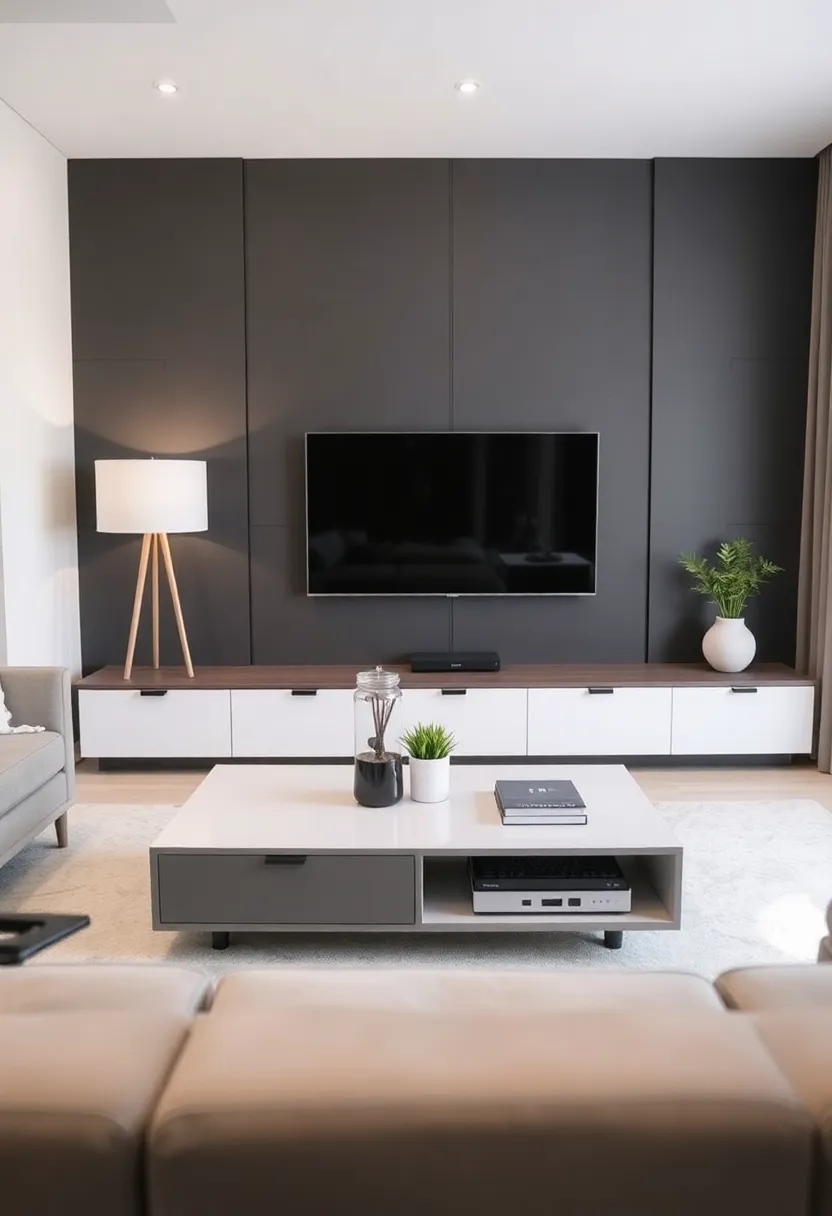
Maximize your living space with multi-functional furniture that doubles as a stylish media center. Consider a coffee table with built-in storage or an ottoman that holds blankets and magazines. This keeps your room looking clean while ensuring everything you need is within reach, perfect for entertaining guests.
When choosing furniture, opt for pieces that align with minimalist designs. Look for neutral colors and sleek lines to keep your space cohesive. You can find affordable options at local furniture stores or online. This approach creates a functional yet stylish environment where you can relax comfortably.
• Select furniture with hidden compartments.
• Ensure height is proportional to your seating.
• Use matching materials for a unified look.
• Consider nesting tables for versatility.
With these tips, your living room can be stylish and functional, making it a welcoming retreat.
Multi-Functional Furniture
Editor’s Choice

SONGMICS MAZIE Collection – 43 Inches Folding Storage Ottoman Bench, Ott…
 Amazon$49.98
Amazon$49.98
SUPER DEAL Nesting Tables Set of 3, Industrial C Shaped End Table Stacka…
 Amazon$57.99
Amazon$57.99
OLIXIS Wood Lift Top Coffee Table with Hidden Compartment and Large Stor…
 Amazon$63.03
Amazon$63.036. Color-Coordinated TV Wall
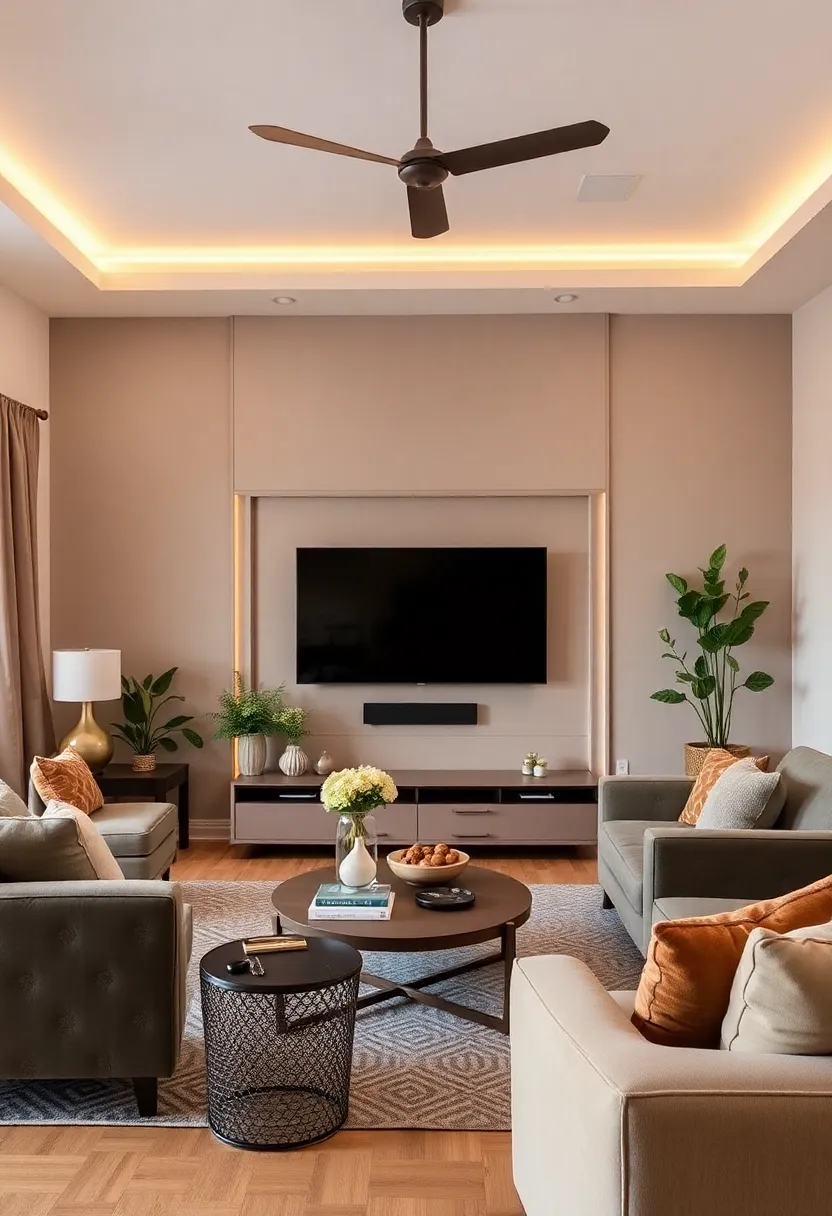
A color-coordinated TV wall creates harmony in your living room. Choose a wall color that matches or complements your furniture for a cohesive look. Soft pastels or warm neutrals can make your space feel inviting and stylish. This trendy approach can tie your room together beautifully.
To enhance this idea, consider painting your TV frame or shelving in the same hue. This creates a polished appearance that feels intentional. Add pops of color through decorative items to keep your room lively and engaging.
• Select a color palette that reflects your personality.
• Use various shades of the same color for depth.
• Incorporate contrasting colors in decor items.
• Choose decor that tells your story.
With these ideas, your living room can feel cohesive and stylish, perfect for showcasing your personality.
Color-Coordinated TV Wall
Editor’s Choice

Zinsser 02774 PERMA-WHITE Mold & Mildew Proof Interior Paint, Quart, Egg…
 Amazon$18.12
Amazon$18.12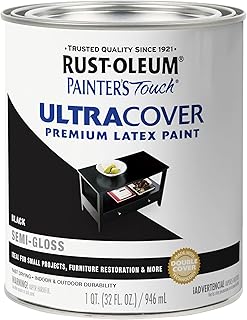
Rust-Oleum 1974502 Painter’s Touch Latex Paint, Quart, Semi-Gloss Black …
 Amazon$16.98
Amazon$16.98
Zhengmy 2 Pieces Metal Tree Leaf Wall Decor Vine Olive Branch Leaf Wall …
 Amazon$15.99
Amazon$15.997. Minimalist Built-In Units
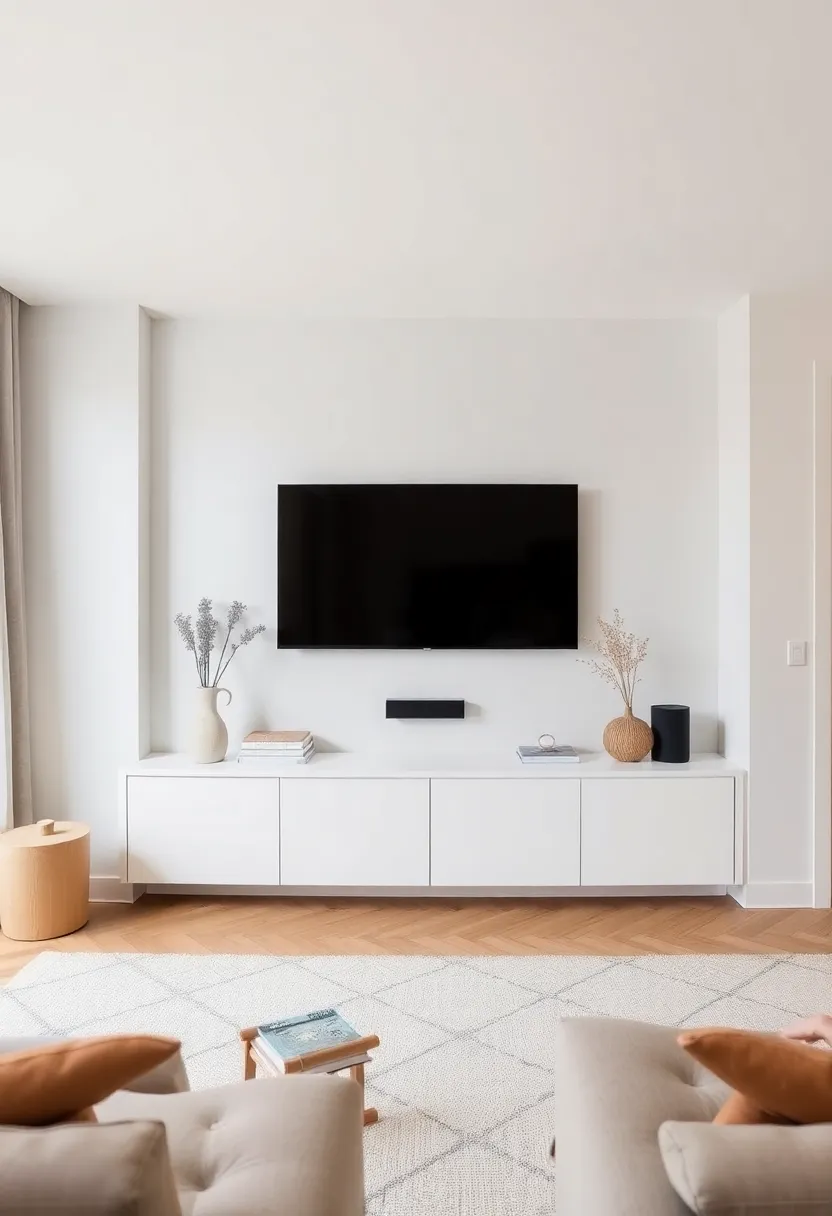
Built-in units offer a neat solution for your TV wall. This design works especially well in smaller spaces, allowing your TV to blend seamlessly into the wall. A minimalist approach keeps the focus on your TV without overwhelming the room. Paint the unit the same color as the wall for a subtle effect.
You can add small potted plants or decorative boxes to personalize the space without cluttering it. Look for affordable built-in solutions at home stores or consider DIY options. This design creates a tranquil environment, making your living room feel more expansive.
• Ensure proper ventilation for electronics.
• Use adjustable shelving for flexibility.
• Hide wires for a clean look.
• Incorporate decorative accents for warmth.
With these tips, your living room can feel organized and stylish, perfect for enjoying downtime.
Fun fact: Minimalist built-in units in living room tv wall ideas can reclaim up to 25% more floor space in small rooms. Keep it clean and flexible with adjustable shelving, and watch how the whole setup feels lighter, calmer, and more practical.
Minimalist Built-In Units
Editor’s Choice

Amazon Basics 5-Shelf Adjustable, Heavy Duty Storage Shelving Unit on 4’…
 Amazon$54.99
Amazon$54.99
Cord Management Organizer Kit 4 Cable Sleeve split with 41Self Adhesive …
 Amazon$15.55
Amazon$15.55
Der Rose 2 Pack Small Fake Plants Mini Artificial Potted Plants for Tabl…
 Amazon$6.99
Amazon$6.998. Modular TV Walls
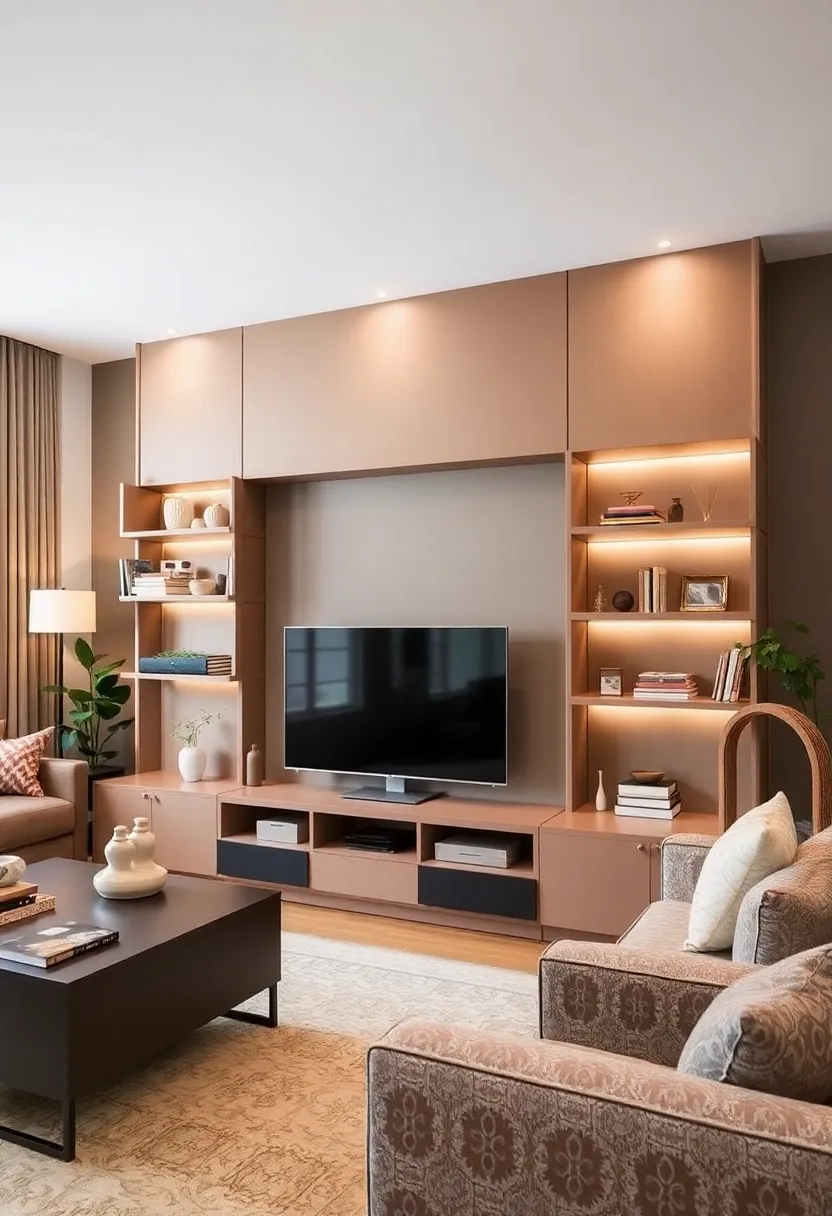
Modular TV walls offer flexibility and style for your living room. This design allows you to rearrange components to suit your needs, whether for movie nights or casual gatherings. Choose a design that matches your aesthetic, mixing wood and metal for added interest. Modular units provide great storage solutions while keeping your space clutter-free.
Opt for units with wheels for easy movement and reconfiguration. You can find various designs online or at furniture stores. This approach offers a personalized touch, making your living room feel uniquely yours.
• Explore different configurations for versatility.
• Personalize with decorative items that reflect your style.
• Ensure storage is functional and accessible.
• Use bright colors for a lively touch.
With these tips, your living room can adapt to any occasion while looking stylish.
Modular TV Walls
Editor’s Choice

Modular TV Stand for 100-Inch TV,Also Used as Storage Sideboards,Bookcas…
 Amazon$169.99
Amazon$169.99
Yizosh Metal Garage Storage Cabinet with Locking Doors and Adjustable Sh…
 Amazon$154.99
Amazon$154.99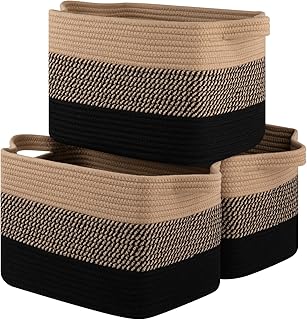
Storage Basket for Organizing, Woven Baskets for Storage, Rectangle Deco…
 Amazon$25.64
Amazon$25.649. Wall Color Contrast

Create drama with contrasting colors on your TV wall. Bold colors like deep navy or charcoal can make your TV a focal point without overwhelming the room. This approach works well in minimalist settings, where less is more. Balance darker colors with lighter furniture to keep the space feeling open.
Consider adding artwork to create a gallery effect around your TV. You can experiment with paint samples to find the perfect contrast. This design brings visual interest and makes your living room feel more dynamic.
• Test paint samples for the best look.
• Keep decor items in sync with your color scheme.
• Use similar tones in textiles for cohesion.
• Add lighting to highlight features.
With these ideas, your living room can become a stylish haven, full of character.
Wall Color Contrast
Editor’s Choice

Sherwin Williams Colors collection Deck Complete Paint Colors
 Amazon$44.00
Amazon$44.00
upsimples 10 Pack Picture Frames Collage Wall Decor for Mounting or Tabl…
 Amazon$21.59
Amazon$21.59
H.VERSAILTEX Velvet Stretch Couch Cushion Cover Plush Cushion Slipcover …
 Amazon$23.49
Amazon$23.4910. Slimline Media Consoles

Slimline media consoles are perfect for those who want a minimalist look while having a designated TV area. These consoles provide functionality without taking up too much space, allowing other elements in the room to shine. Look for designs with clean lines and sleek features to keep your space feeling open.
Choose a console that combines open and closed storage to keep electronics handy while hiding clutter. Pair it with wall-mounted decor for a polished look. This design creates a tranquil environment, perfect for relaxing evenings.
• Ensure it fits your TV size for balance.
• Add decorative items like plants for warmth.
• Choose materials that match your furniture.
• Keep cables organized for a clean look.
With these tips, your living room can be functional and stylish, creating a calming atmosphere.
Slimline Media Consoles
Editor’s Choice

TV Stand, Media Console Table with Sliding Door and Storage Compartment,…
 Amazon$199.00
Amazon$199.00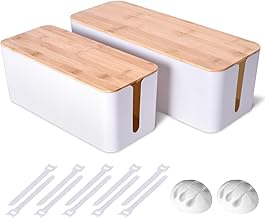
2 Pack Large Cable Management Box – Wooden Style Cord Organizer and Cove…
 Amazon$25.99
Amazon$25.99
3 Link Wood Knot Decor – Hand Carved Coffee Table Decoration, Boho Chain…
 Amazon$14.99
Amazon$14.9911. Artistic Displays
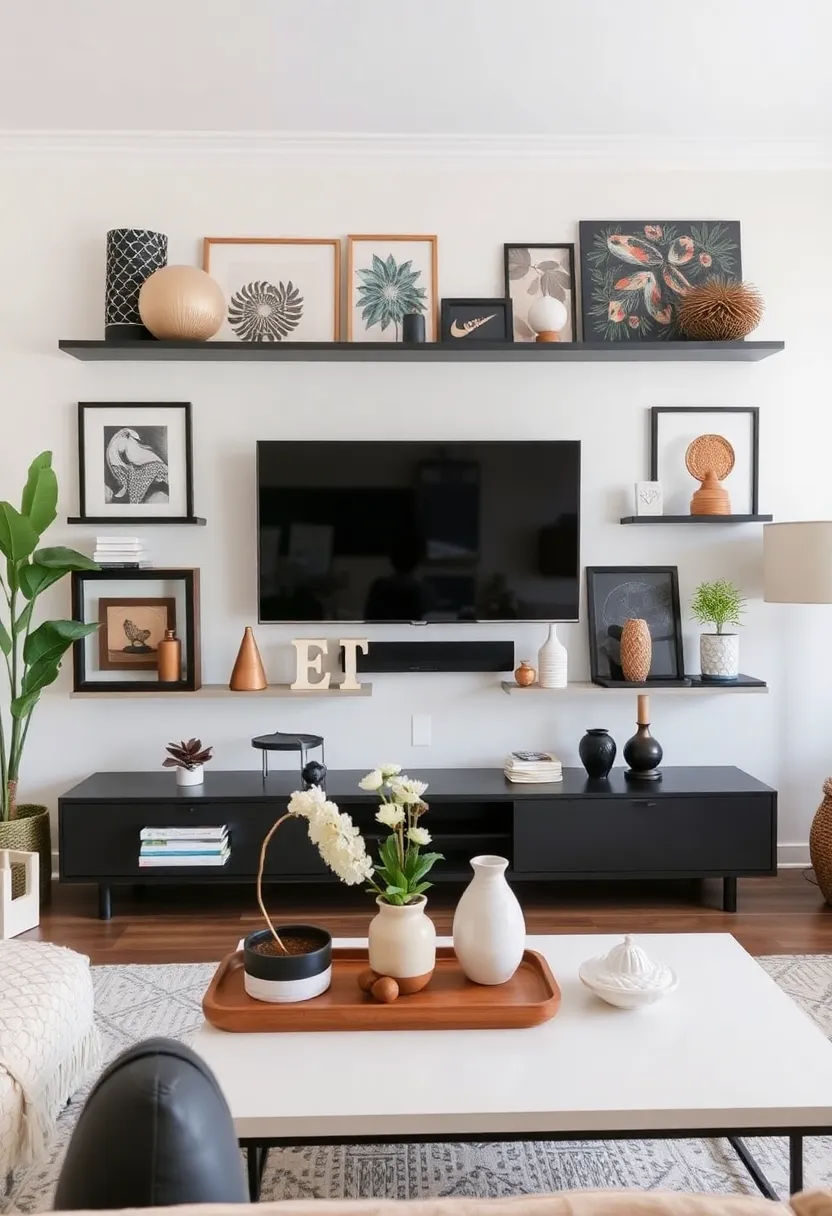
Turn your TV wall into a piece of art by curating decorative displays around your television. This could include wall-mounted art, shelves filled with decor, or a statement painting. The goal is to create a cohesive look that is both functional and stylish. Choose art that resonates with your personal style and matches your color palette.
Incorporate different shapes and sizes for added interest, but remember to maintain balance. You can arrange a gallery-style layout around the TV for a flowing effect. This design helps your living room feel artistic and inviting.
• Keep decor at eye level for easy viewing.
• Incorporate soft lighting to highlight art pieces.
• Use a mix of textures for depth.
• Choose themed decor for a unified look.
With these ideas, your living room can feel like an artistic haven that showcases your taste.
Turn your TV wall into art that stays functional. Start with 3–5 decor pieces arranged gallery-style around the screen, then swap in seasonal pieces to keep the balance fresh. This living room tv wall ideas approach feels calm, cohesive, and stylish.
Artistic Displays
Editor’s Choice

97 Decor Eclectic FRAMED Wall Art Set – Colorful Eclectic Decor, Retro C…
 Amazon$69.99
Amazon$69.99
Minimalistic Black Shelf Brackets by Delta Cycle, Set of 10 Fully Adjust…
 Amazon$59.99
Amazon$59.99
EZVALO Picture Light for Wall, 4800mAh Rechargeable Wireless Remote Ligh…
 Amazon$23.69
Amazon$23.6912. Vertical Gardens

Bring nature indoors with a vertical garden on your TV wall. This design adds a fresh, green touch while enhancing your room’s overall look. Incorporating plants can also improve air quality, making it a functional choice. Opt for wall-mounted planters that hold various low-maintenance plants like ferns or succulents.
Ensure your plants receive enough light, either from natural sunlight or grow lights. This design can create a vibrant atmosphere without demanding too much care. Your living room becomes a calming retreat filled with life.
• Choose a plant color palette that fits your decor.
• Use containers that match your wall color for coherence.
• Incorporate a watering system for easy maintenance.
• Select low-light plants for versatility.
With these tips, your living room can feel alive and inviting, perfect for relaxation.
Vertical Gardens
Editor’s Choice
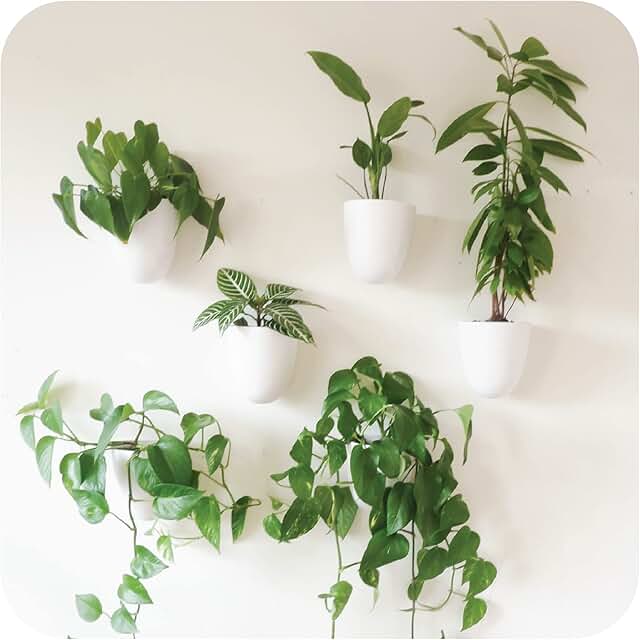
PlantPod Luxe – Self-Watering Wall Planters (Set of 6) – Easy to Water a…
 Amazon$35.95
Amazon$35.95
Costa Farms Boston Fern Live Plant, Outdoors or Indoor Houseplant in 10-…
 Amazon$23.99
Amazon$23.99
Automatic Plant Waterer Indoor Self Watering System for 15 Potted Plants…
 Amazon$32.99
Amazon$32.9913. Monochromatic Palette
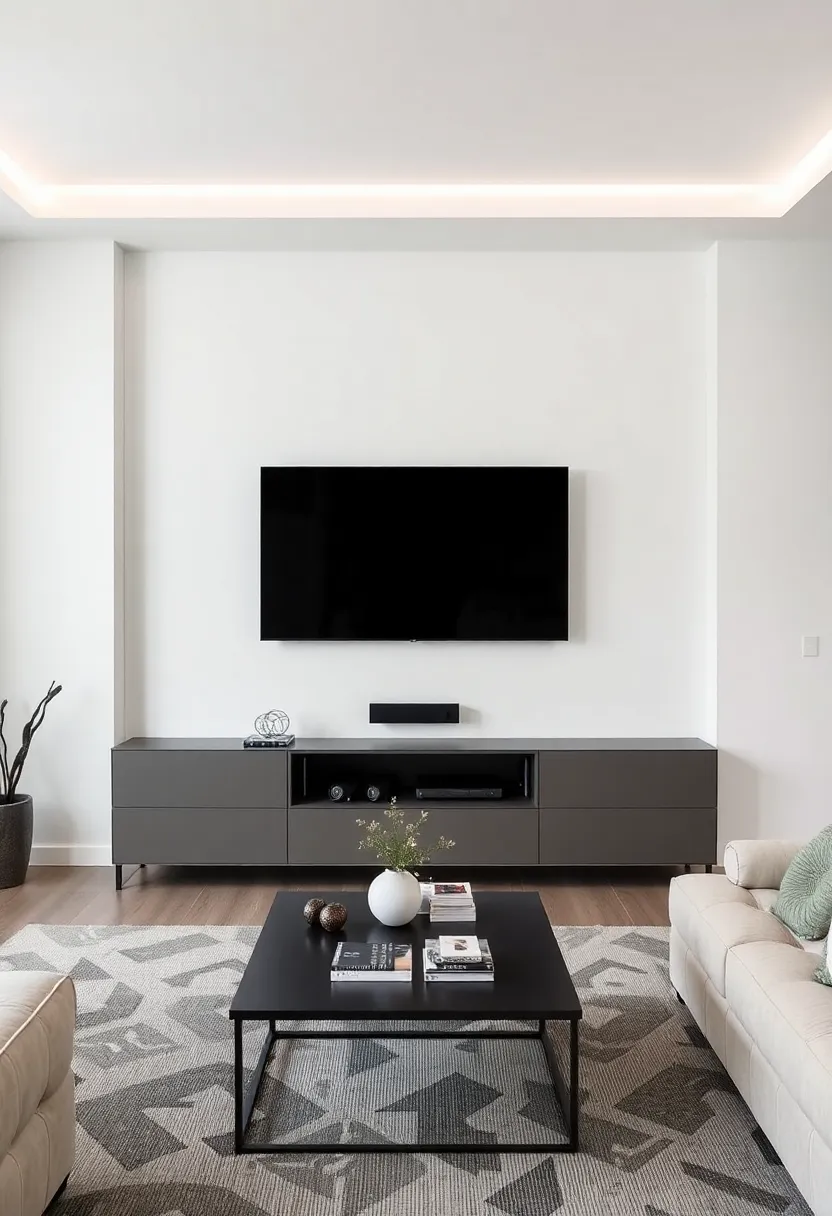
Create a sophisticated look with a monochromatic color scheme for your TV wall. This style can make your living room feel calm and cohesive. Choose one color and play with various shades and textures to add depth without overwhelming the space. You can mix materials like matte walls with glossy decor for interest.
Using the same color for the wall and surrounding decor creates a seamless flow that can visually expand your room. This design is perfect for minimalists who appreciate clean lines.
• Use varying textures for contrast.
• Incorporate metallic elements for glam.
• Play with shapes and sizes in decor.
• Add layered lighting for depth.
With these ideas, your living room can embrace sophistication and elegance, making it a serene space.
Monochromatic Palette
Editor’s Choice

Art3dwallpanels 33 Pack 3D Wall Panel Diamond for Interior Wall Décor, P…
 Amazon$42.99
Amazon$42.99
Deco 79 Metal Abstract Decorative Sculpture Swirl Home Decor Statue, Acc…
 Amazon$27.89
Amazon$27.89
Jartinle Abstract Mid Century Modern Throw Pillow Covers 18×18 Colorful …
 Amazon$19.99
Amazon$19.9914. Oversized Art Behind the TV
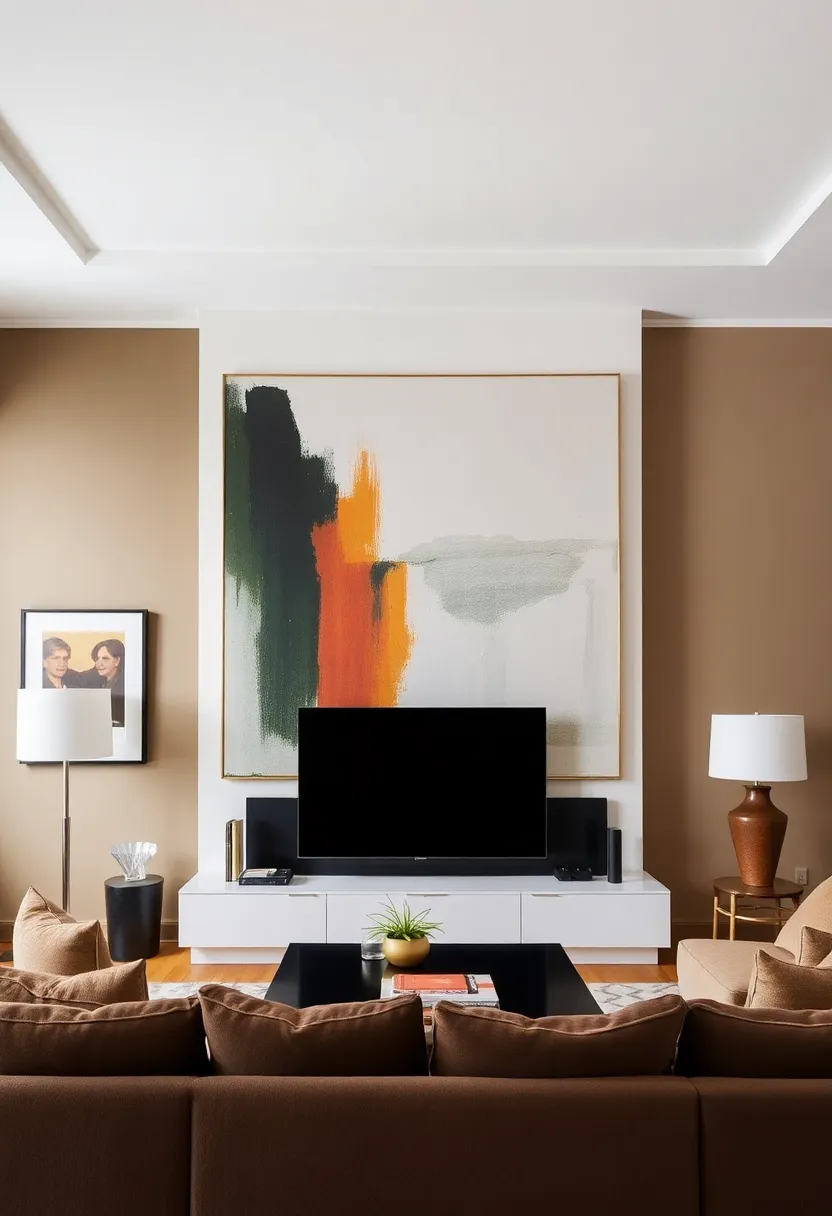
Let your TV act as a frame for oversized art. Placing a large piece of art behind your television creates a striking focal point that draws the eye. This design instantly uplifts your living room’s style, transforming the TV area into a gallery-like setting. Choose art that complements your color scheme for a cohesive look.
Bright colors can energize a neutral space, while softer hues can create a calming atmosphere. This approach cleverly disguises the TV when it’s not in use, blending functionality with style.
• Ensure art is securely mounted to avoid accidents.
• Choose a frame that matches your furniture style.
• Arrange furniture to encourage conversation.
• Use layered lighting to highlight the art.
With these tips, your living room can become a stylish haven that showcases your personality and taste.
Oversized Art Behind the TV
Editor’s Choice

184 Pieces Picture Hanging Kit, 20lb, 30lb, and 50lb Picture Hangers, Me…
 Amazon$6.99
Amazon$6.99
Large Canvases for Painting 36×48 Inch 2-Pack, 12.3 oz Triple Primed Aci…
 Amazon$85.49
Amazon$85.49
Umbra, Black Exhibit Multi Picture Frame Photo Display
 Amazon$55.99
Amazon$55.9915. Layered Textures
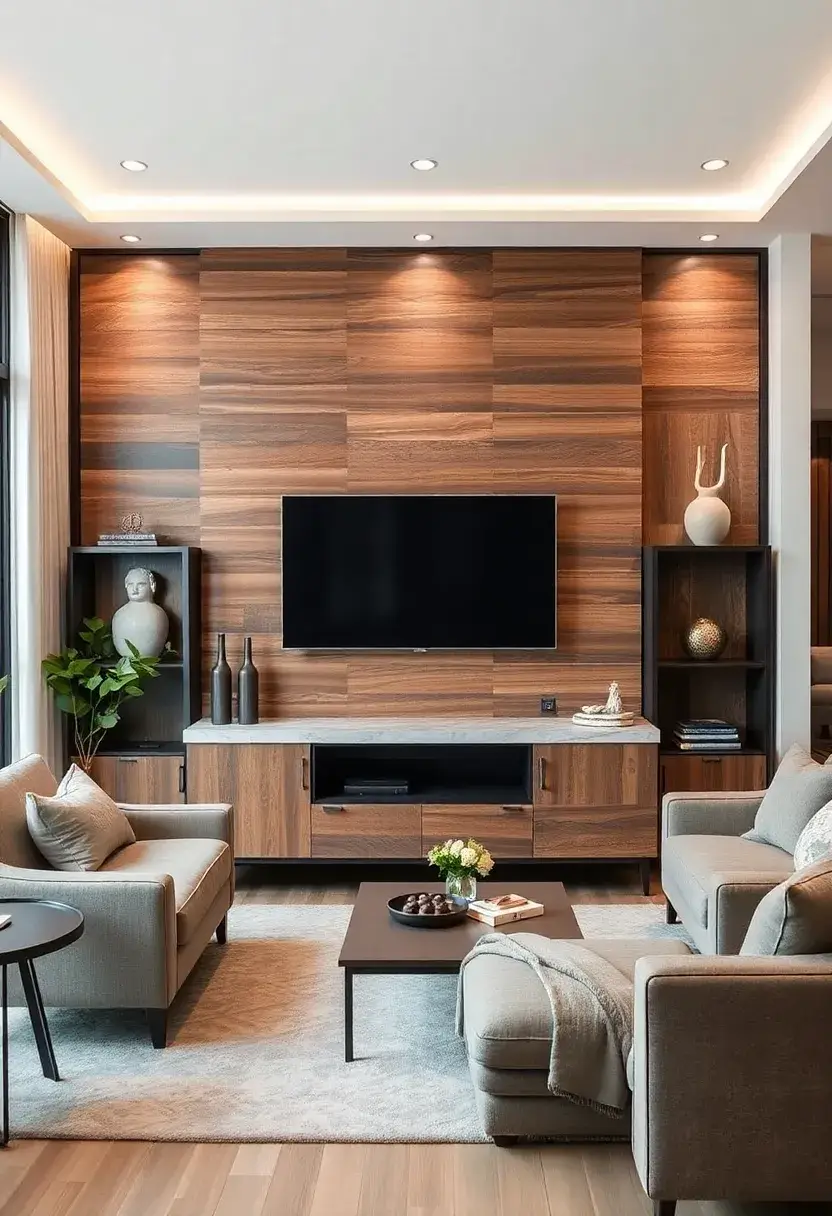
Incorporate various textures on your TV wall to create warmth and visual intrigue. This approach can make your living room feel inviting while adding depth to the design. Use materials like wood, metal, and fabric along with your TV setup for a multi-dimensional look.
Layering can be achieved through decorative items on shelves, art in different materials, or a textured accent wall behind the TV. Choose a cohesive color palette to maintain harmony throughout your space.
• Mix smooth and rough surfaces for contrast.
• Use a statement rug to tie textures together.
• Incorporate highlighting lighting to showcase textures.
• Add decorative accents for personality.
With these ideas, your living room can become a cozy retreat filled with character.
Layered Textures
Editor’s Choice

Art3dwallpanels 33 Pack 3D Wall Panel Diamond for Interior Wall Décor, P…
 Amazon$42.99
Amazon$42.99
5×7 Area Rug Living Room Rug: Washable Modern Abstract Soft Thin Rug Ind…
 Amazon$26.99
Amazon$26.99
SUNMORY Floor Lamps for Living Room, 32W/3000LM Super Bright LED Floor L…
 Amazon$40.99
Amazon$40.9916. Glass Front Cabinets
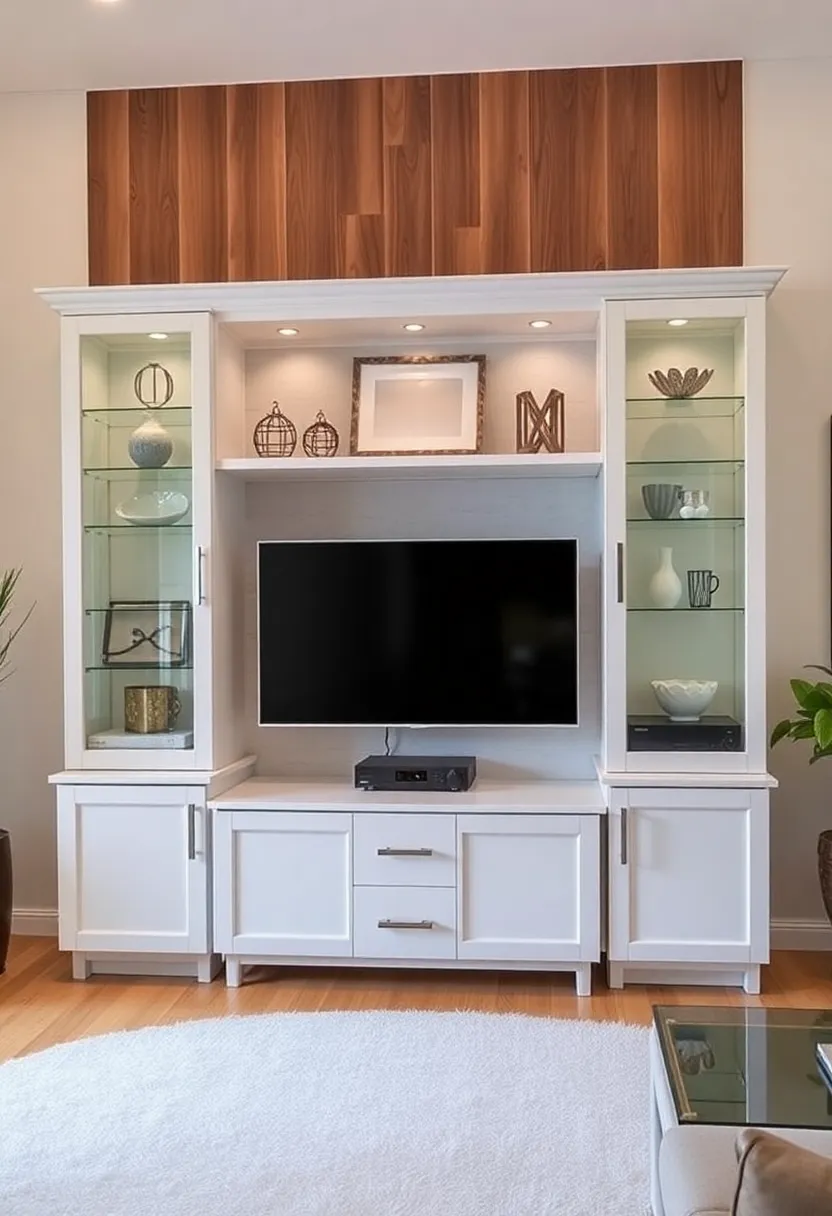
Glass front cabinets offer an elegant way to showcase your media equipment while keeping dust at bay. These cabinets display decorative items or books stylishly while hiding cables and electronics. The transparency of glass helps make the room feel open and less cluttered.
Choose minimalist designs that align with your decor style. Adding LED lights inside can enhance the beauty of displayed items, creating a soft glow. This design keeps your living room looking chic and organized, perfect for entertaining guests.
• Ensure the glass is high-quality and easy to clean.
• Use matching decor inside for consistency.
• Consider frosted glass for a modern touch.
• Add decorative boxes to conceal smaller items.
With these tips, your living room can feel stylish and organized, showcasing your taste.
Glass Front Cabinets
Editor’s Choice

FOTOSOK 71” Tall Kitchen Cabinet with Glass Doors and Drawer, Freestand…
 Amazon$169.99
Amazon$169.99
Govee White LED Strip Lights, Upgraded 16.4ft Dimmable LED Light Strip 6…
 Amazon$19.99
Amazon$19.99
Irregular Frosted Shaped Modern Minimalist Glass Vase – Fashionable Mult…
 Amazon$22.99
Amazon$22.9917. Stylish Surround Sound Setup

Enhance your living room experience with a stylish surround sound setup. This can elevate movie nights and boost your home’s overall vibe. Opt for sleek, wall-mounted speakers that integrate discreetly into your TV wall design.
Consider a Bluetooth system for easy control without messy wires. Hidden subwoofers can also amplify sound quality while maintaining a polished look. This design creates a dynamic atmosphere, perfect for entertainment.
• Choose speaker colors that match your decor.
• Position speakers strategically for optimal sound.
• Incorporate soft fabrics to improve acoustics.
• Add decorative accents to enhance style.
With these ideas, your living room can become the ultimate entertainment space, inviting friends and family to enjoy time together.
Stylish Surround Sound Setup
Editor’s Choice

Polk Audio RC55i 2-Way Premium in-Wall 5.25″ Home Stereo Speakers (Pair)…
 Amazon$149.00
Amazon$149.00
ULTIMEA 7.1ch Sound Bar with Subwoofer, Virtual Surround Sound System fo…
 Amazon$99.99
Amazon$99.99
Focusound 52 Pack Acoustic Foam Panels 1″ x 12″ x 12″ Sound Proof Foam P…
 Amazon$36.99
Amazon$36.9918. Geometric Wall Panels

Add modern flair to your TV wall with geometric wall panels. This design creates a striking visual effect that makes your living room stand out. Panels can be painted in complementary colors or left in their natural finish for a rustic touch.
These panels also help with sound absorption, making them functional as well as stylish. Arrange the panels to frame the TV and draw attention to it without overwhelming the space. This approach enhances your living area’s aesthetics.
• Use varying panel sizes for interest.
• Ensure colors harmonize with your furniture.
• Incorporate LED lighting around the panels for effect.
• Choose textured finishes for depth.
With these tips, your living room can feel modern and inviting, perfect for gatherings.
Geometric wall panels are a standout in living room tv wall ideas, cutting echo by up to 30% for clearer dialogue. Paint them in a calm hue to complement your TV and keep the room airy.
Geometric Wall Panels
Editor’s Choice

Art3dwallpanels 33 Pack 3D Wall Panel Diamond for Interior Wall Décor, P…
 Amazon$42.99
Amazon$42.99
DAYBETTER LED Strip Lights 130ft Lights Strip for Bedroom, Desk, Indoor …
 Amazon$9.99
Amazon$9.99
KILZ TRIBUTE Paint & Primer, Interior, Color Sample, Collector’s White, …
 Amazon$9.90
Amazon$9.9019. Creative Cable Management
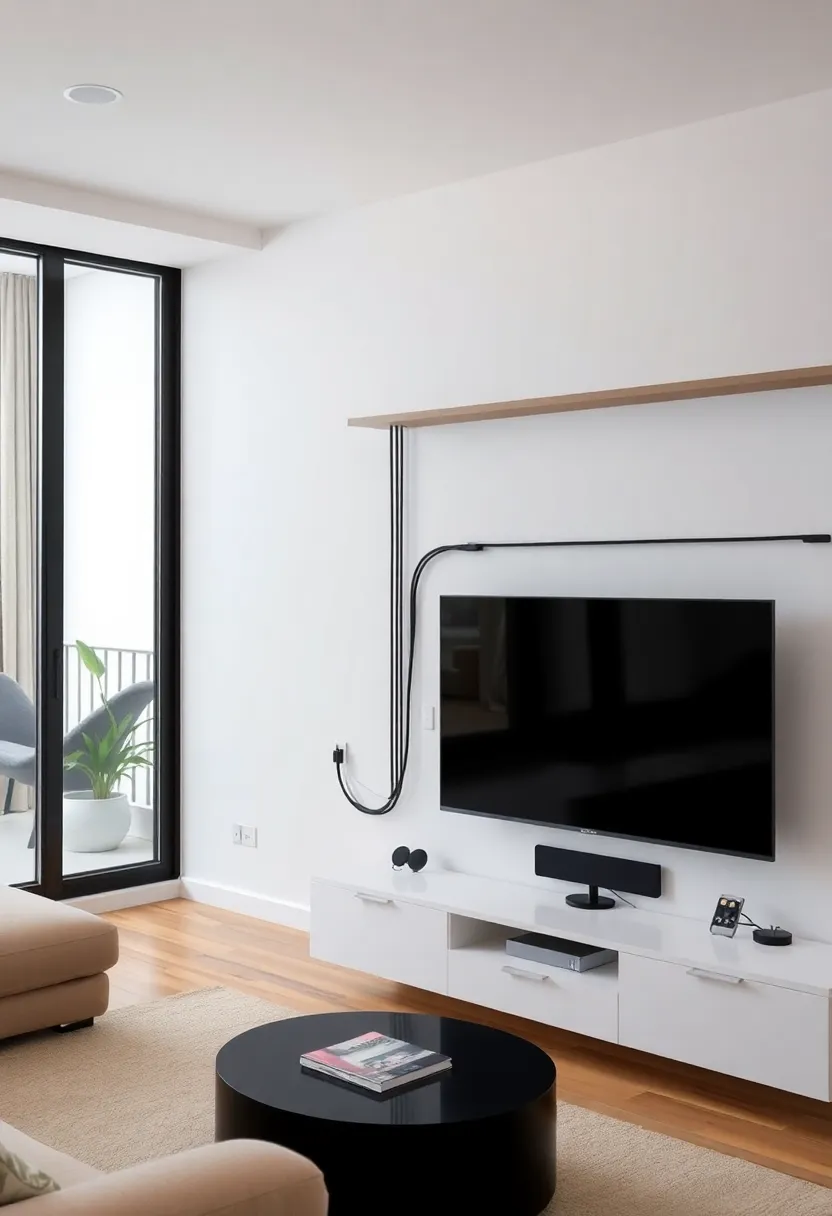
Keep your living room looking chic with creative cable management solutions. Unsightly cables can detract from even the most stylish TV wall, so find ways to conceal them. Use cable covers, conduits, or decorative boxes to hide cables while ensuring they stay accessible.
Wall-mounted cable management systems can keep everything organized and out of sight. Make sure to secure everything properly, especially if you have kids or pets. This design helps maintain a clean look in your living space.
• Label cables for easy identification.
• Use adhesive clips for smooth cable runs.
• Opt for wireless gear to reduce clutter.
• Create designated areas for chargers and devices.
With these tips, your living room can feel organized and stylish, making relaxation a breeze.
Creative Cable Management
Editor’s Choice

JOTO 4 Pack Cable Management Sleeve, 19-20 Inches Cord Organizer System …
 Amazon$9.99
Amazon$9.99
60 PCS XHF 5/8” Adhesive Cable Wire Clips Clear, Cable Staples Outdoor C…
 Amazon$6.99
Amazon$6.99
Book Shape Decorative Cable Management Box – Expandable Cable Organizer …
 Amazon$32.00
Amazon$32.0020. Minimalist Media Wall with Hidden Storage
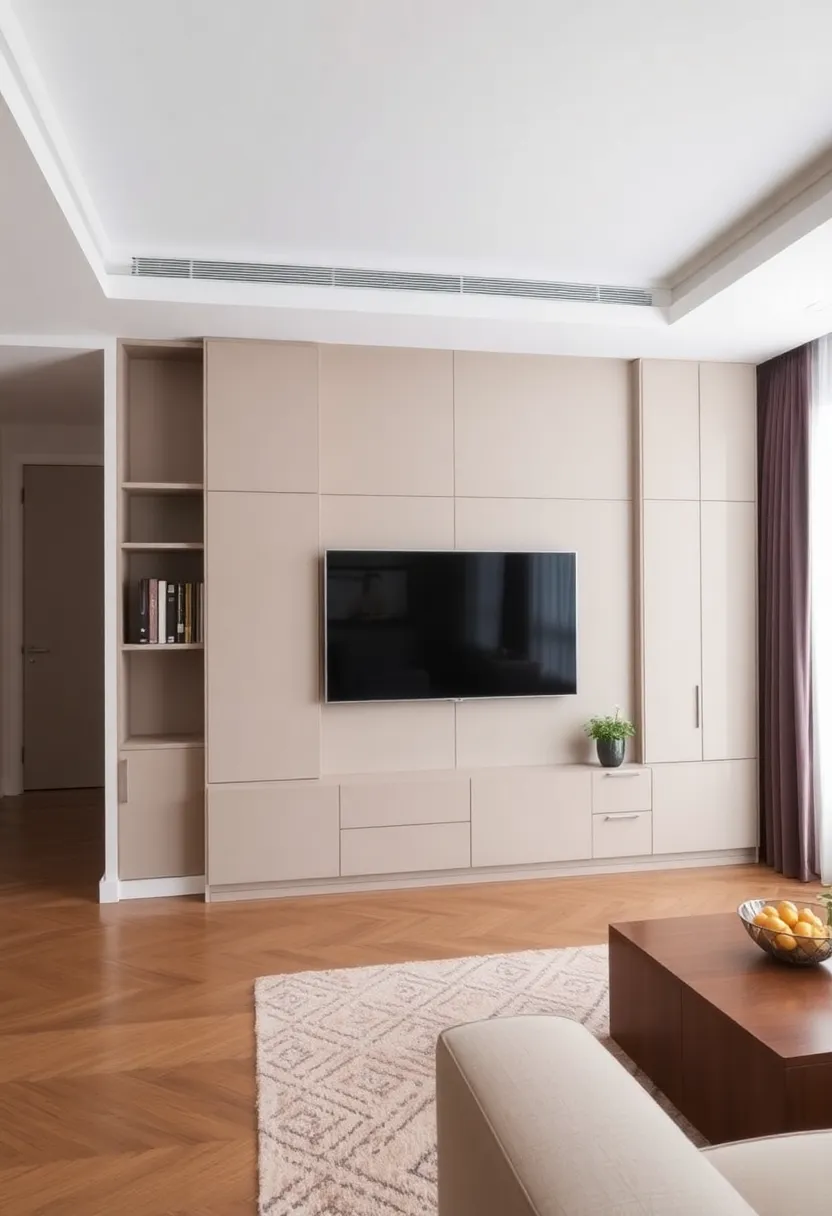
Achieve a clean, minimalist look with a media wall that hides storage. This setup cleverly conceals equipment and accessories, allowing your TV to shine as the central feature. Choose cabinetry that blends with your wall color and decor for a cohesive appearance.
Opt for push-to-open mechanisms to keep a clean and uncluttered look. This design is perfect for small rooms, maximizing space while keeping everything organized. Your living room can feel open and stylish, perfect for entertaining.
• Ensure good ventilation for electronics in storage.
• Use matching decor for visual consistency.
• Incorporate soft lighting for ambiance.
• Choose accessible storage solutions for ease.
With these ideas, your living room can be both chic and functional, ready for gatherings.
Minimalist Media Wall with Hidden Storage
Editor’s Choice

HollyHOME Bamboo TV Stand with Storage for TVs up to 65”, Modern Entert…
 Amazon$109.49
Amazon$109.49
Zonon 8 Pack Magnetic Push Latch Heavy Duty Push to Open Cabinet Hardwar…
 Amazon$16.99
Amazon$16.99
KSIPZE 100ft Led Strip Lights RGB Music Sync Color Changing Bluetooth Le…
 Amazon$9.99
Amazon$9.9921. Statement Lighting
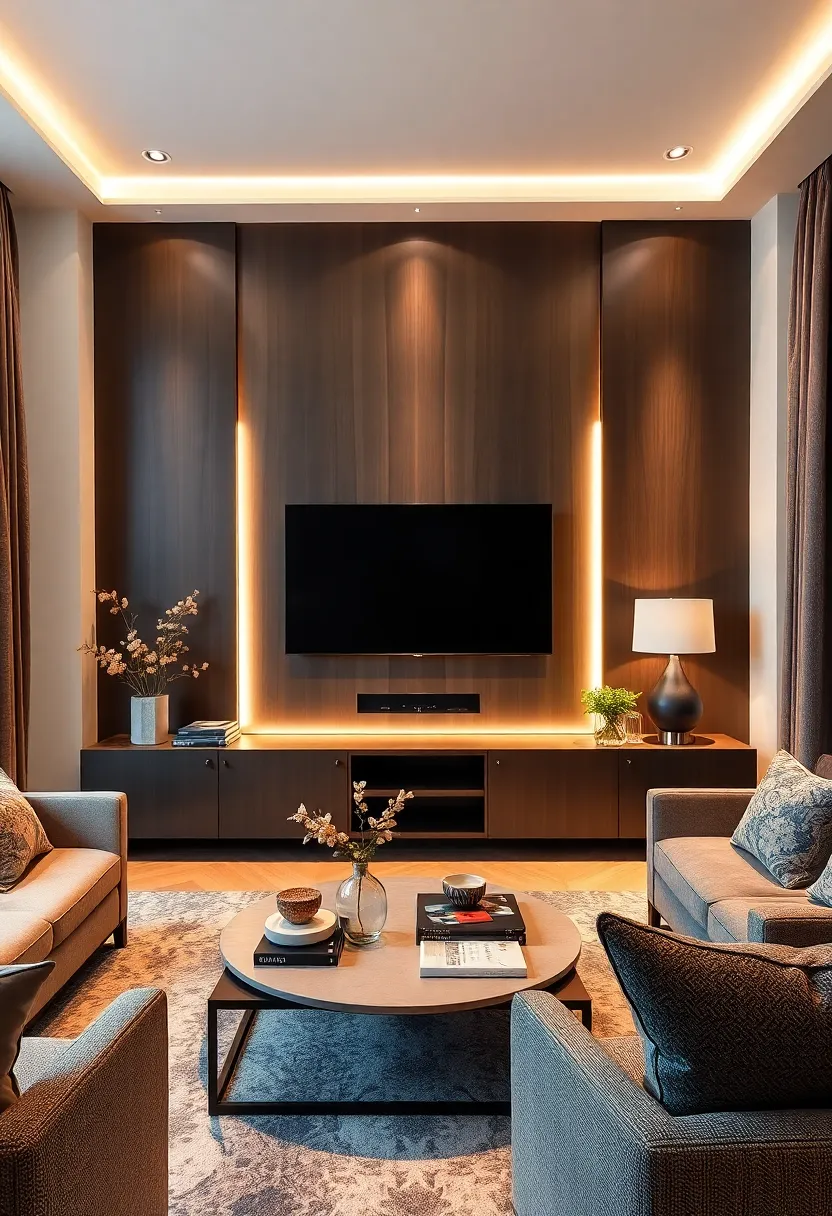
Elevate your living room TV wall with statement lighting. This could include striking pendant lights, stylish sconces, or color-changing LED strips. Statement lighting serves a functional role while enhancing your decor. Position lights to highlight your TV and decor, creating a warm atmosphere.
Dimmable options can set the mood for movie nights or casual gatherings. Choose fixtures that align with your decor style, whether modern, rustic, or eclectic. With thoughtful lighting, your living room can feel inviting and stylish.
• Use dimmable options for versatility.
• Choose fixtures that match your decor style.
• Consider directional lights for focus.
• Add soft lighting for a cozy vibe.
With these ideas, your living room can become a warm and welcoming space for family and friends.
Statement Lighting
Editor’s Choice

Govee White LED Strip Lights, Upgraded 16.4ft Dimmable LED Light Strip 6…
 Amazon$19.99
Amazon$19.99
TRLIFE Wall Sconce Plug in, Dimmable Wall Sconce with Switch Swing Arm W…
 Amazon$31.99
Amazon$31.99
MAYNA Modern LED Pendant Light, Chrome Island Lights for Kitchen, 22W Ad…
 Amazon$31.99
Amazon$31.9922. Vintage-Inspired TV Wall

Embrace nostalgia with a vintage-inspired TV wall that blends old-world charm with modern convenience. This could include retro shelving units, antique decor items, or a vintage-style TV stand that complements your setup. Earthy tones and rustic materials create warmth and history in your living room.
Mixing modern elements with vintage pieces creates a curated look. You can find unique finds at thrift stores or flea markets. This design brings character and personality to your space.
• Explore thrift stores for one-of-a-kind items.
• Incorporate vintage artwork to enhance the theme.
• Use warm lighting for a cozy atmosphere.
• Pair vintage pieces with modern designs for contrast.
With these tips, your living room can radiate charm and warmth, perfect for welcoming guests.
Vintage-Inspired TV Wall
Editor’s Choice

mopio Ensley TV Stand, Mid Century Modern for 55/60/65 inch TV, Farmhous…
 Amazon$189.99
Amazon$189.99
VIYYIEA Vintage Gold Framed Wall Art for Living Room, Birds Canvas Print…
 Amazon$17.99
Amazon$17.99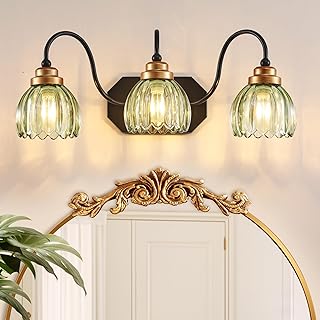
Vintage Bathroom Vanity Light, Bathroom Lighting Fixtures Over Mirror, M…
 Amazon$79.99
Amazon$79.9923. Open Concept Storage
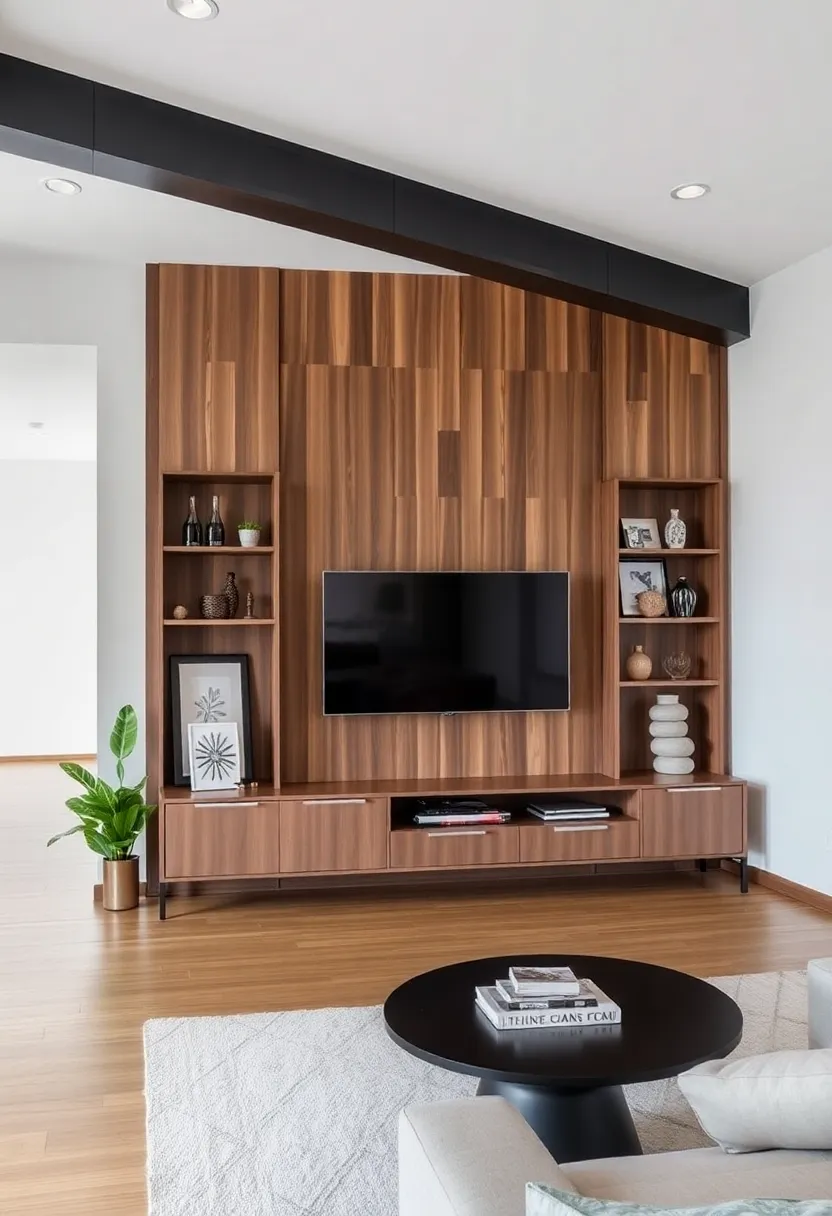
If you have an open-concept living area, consider using your TV wall for open storage that doubles as decor. This could include bookshelves or display units that showcase your favorite items while housing media equipment. Open storage encourages curation, making your space feel intentional.
Choose sleek, modern designs that align with your minimalist style and display items that reflect your personality. This approach keeps your living area organized and stylish.
• Balance decorative items with practical storage.
• Use a consistent color palette for harmony.
• Keep frequently used items at eye level.
• Incorporate plants for a fresh touch.
With these ideas, your living room can feel open and inviting, perfect for gatherings.
Open Concept Storage
Editor’s Choice

IOTXY 5-Tier Wooden Shelf Bookcase – Modern Open Bookshelf, Free Standin…
 Amazon$109.99
Amazon$109.99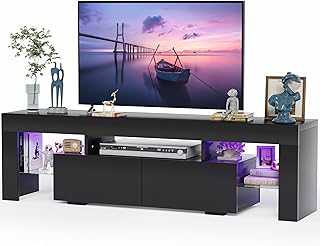
JUMMICO TV Stand, Modern Lighting TV Cabinet Entertainment Center Media …
 Amazon$119.99
Amazon$119.99
Storage Basket for Organizing, Woven Baskets for Storage, Rectangle Deco…
 Amazon$25.64
Amazon$25.6424. Minimalist Wall-Mounted TV with Surrounding Decor

Keep your TV as the centerpiece with a minimalist wall-mounted design, surrounded by curated decor. This approach keeps the focus on the TV while incorporating personality through decorative elements. Select a simple wall mount to maintain emphasis on the TV, then arrange art or shelves around it.
Balance is key—don’t overcrowd the area. A few carefully placed decor items can enhance the overall look without overwhelming the room. This design creates a stylish atmosphere, perfect for entertaining.
• Use wall-mounted lighting for emphasis.
• Stick to a limited color palette for decor.
• Use decorations that reflect your interests.
• Incorporate personal touches to make it yours.
With these ideas, your living room can feel chic and inviting, ready for socializing.
Minimalist Wall-Mounted TV with Surrounding Decor
Editor’s Choice

Mounting Dream TV Wall Mount for 32-65 Inch Television,Mount with Swivel…
 Amazon$39.97
Amazon$39.97
QEEIG Bathroom Floating Shelves for Wall – 15.7″ Wall Mounted Shelf Over…
 Amazon$16.92
Amazon$16.92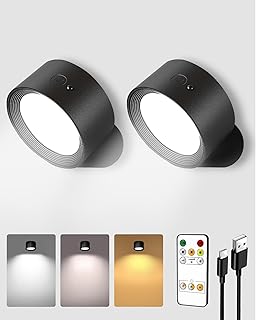
LED Wall Mounted Lights, Rechargeable Wall Sconces Lamp, 3 Color Temps &…
 Amazon$18.98
Amazon$18.9825. Understated Elegance with Light Colors
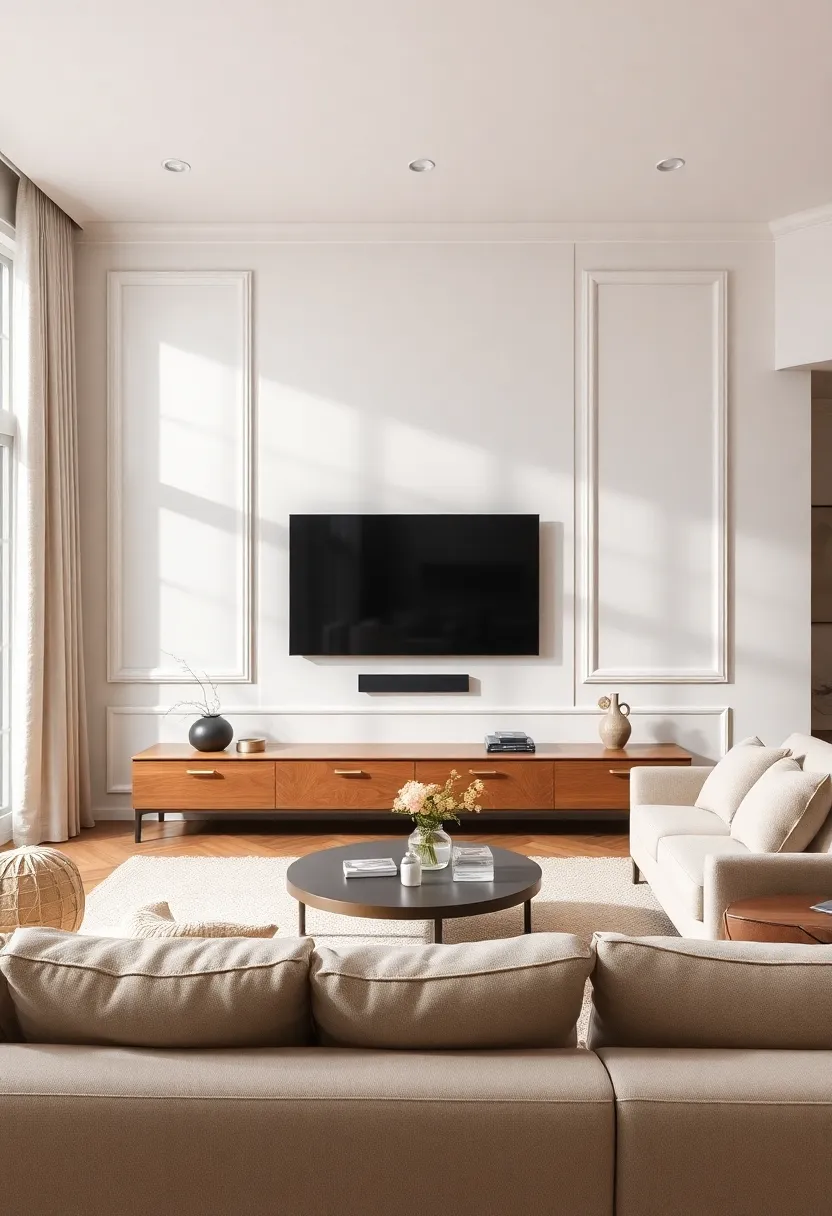
Achieving understated elegance is about selecting light colors and soft textures. A light color palette can make your living room feel spacious and serene while emphasizing comfort and style. Consider a soft off-white or pale pastel for the TV wall, complemented by light-colored furniture and decor.
Soft textiles like light throws or cushions add warmth, inviting relaxation. This design suits minimalists who appreciate clean lines and simple beauty. Your space can feel calm and inviting.
• Introduce layers with rugs or fabrics for depth.
• Use natural light to enhance brightness.
• Incorporate subtle patterns for visual interest.
• Choose decor items that reflect your style.
With these tips, your living room can radiate elegance and serenity, creating a perfect getaway.
Understated Elegance with Light Colors
Editor’s Choice

Bedsure GentleSoft Fleece Throw Blanket for Couch Grey – Lightweight Plu…
 Amazon$9.49
Amazon$9.49
8Pcs 18 x 18 Inch Decorative Throw Pillow Covers Pastel Mix Color Pillow…
 Amazon$19.99
Amazon$19.99
SAFAVIEH Area Rug 9×12 – Natural Fiber Collection – Large – Natural Brow…
 Amazon$358.47
Amazon$358.47Conclusion

Designing your living room TV wall is an opportunity to blend style and functionality beautifully. These 25+ ideas offer diverse approaches, from minimalist floating shelves to textured accent walls, ensuring there’s something for every taste.
As you embark on your design journey, remember to keep your personal style in mind while prioritizing functionality. Your TV wall can be a stunning focal point that enhances your living space, creating an inviting atmosphere for relaxation and entertainment.
Note: We aim to provide accurate product links, but some may occasionally expire or become unavailable. If this happens, please search directly on Amazon for the product or a suitable alternative.
This post contains Amazon affiliate links, meaning we may earn a small commission if you purchase through our links, at no extra cost to you.
Frequently Asked Questions
What Are Some Popular Living Room TV Wall Ideas for a Minimalist Aesthetic?
If you’re embracing a minimalist aesthetic, consider sleek designs that emphasize simplicity and functionality. Popular ideas include floating shelves to display your TV and accessories without clutter, or a that seamlessly integrates with your wall. An accent wall with neutral tones can also provide a beautiful backdrop while keeping the focus on your TV.
How Can I Create a Stylish Media Center That Maximizes Space?
Creating a stylish media center while maximizing space is all about smart design! Look for space-saving furniture such as compact cabinets or modular units that can be adjusted to fit your layout. You can also use wall-mounted solutions to free up floor space. Incorporate decorative elements like plants or art to make your media center a focal point of your living room.
What Are Some Unique TV Wall Design Ideas to Enhance My Living Room Decor?
For unique TV wall design ideas, think outside the box! Consider a around your TV with framed art or photographs to add personality. Alternatively, use a to create depth and interest. You could also play with color by painting an accent wall that complements your existing decor, making your TV wall a stunning centerpiece.
How Do I Choose the Right Accent Wall Inspiration for My Living Room?
Choosing the right accent wall inspiration starts with understanding your style. Browse through styles like to find what resonates with you. You can also consider using bold colors or patterns that tie in with your furniture. Remember, the goal is to create a harmonious look that enhances your overall living room decor while drawing attention to your TV area.
What Materials Work Best for a Modern Living Room TV Wall?
When selecting materials for a modern living room TV wall, opt for for sleek finishes. Wood adds warmth, while metal provides an industrial touch. For a contemporary feel, consider using textured wallpaper or a stone accent wall. Each material can create a unique vibe, so choose one that aligns with your style.
Related Topics
living room tv wall ideas
modern living room decor
minimalist design
TV wall design
stylish media center
space-saving furniture
accent wall inspiration
interior styling
budget friendly
small spaces
DIY home decor
easy updates
Note: We aim to provide accurate product links, but some may occasionally expire or become unavailable. If this happens, please search directly on Amazon for the product or a suitable alternative.
This post contains Amazon affiliate links, meaning we may earn a small commission if you purchase through our links, at no extra cost to you.
Frequently Asked Questions
What Are Some Popular Living Room TV Wall Ideas for a Minimalist Aesthetic?
If you’re embracing a minimalist aesthetic, consider sleek designs that emphasize simplicity and functionality. Popular ideas include floating shelves to display your TV and accessories without clutter, or a that seamlessly integrates with your wall. An accent wall with neutral tones can also provide a beautiful backdrop while keeping the focus on your TV.
How Can I Create a Stylish Media Center That Maximizes Space?
Creating a stylish media center while maximizing space is all about smart design! Look for space-saving furniture such as compact cabinets or modular units that can be adjusted to fit your layout. You can also use wall-mounted solutions to free up floor space. Incorporate decorative elements like plants or art to make your media center a focal point of your living room.
What Are Some Unique TV Wall Design Ideas to Enhance My Living Room Decor?
For unique TV wall design ideas, think outside the box! Consider a around your TV with framed art or photographs to add personality. Alternatively, use a to create depth and interest. You could also play with color by painting an accent wall that complements your existing decor, making your TV wall a stunning centerpiece.
How Do I Choose the Right Accent Wall Inspiration for My Living Room?
Choosing the right accent wall inspiration starts with understanding your style. Browse through styles like to find what resonates with you. You can also consider using bold colors or patterns that tie in with your furniture. Remember, the goal is to create a harmonious look that enhances your overall living room decor while drawing attention to your TV area.
What Materials Work Best for a Modern Living Room TV Wall?
When selecting materials for a modern living room TV wall, opt for for sleek finishes. Wood adds warmth, while metal provides an industrial touch. For a contemporary feel, consider using textured wallpaper or a stone accent wall. Each material can create a unique vibe, so choose one that aligns with your style.
Related Topics
living room tv wall ideas
modern living room decor
minimalist design
TV wall design
stylish media center
space-saving furniture
accent wall inspiration
interior styling
budget friendly
small spaces
DIY home decor
easy updates

